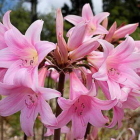 Warm bright sun on the garden. And even in it a lot of work, it does not. We seem to wake up from the winter hibernation along with nature. We sometimes on seedlings under the film the thermal-loving annuals, and at a permanent place - the semids, poorly carrying a transplant. In flower beds loosen the soil, make feeding and impose a mulch, by the way, cleaning the country house and the guidance of the order on the site is always done in the spring. From perennials, on the contrary, it is removed.
Warm bright sun on the garden. And even in it a lot of work, it does not. We seem to wake up from the winter hibernation along with nature. We sometimes on seedlings under the film the thermal-loving annuals, and at a permanent place - the semids, poorly carrying a transplant. In flower beds loosen the soil, make feeding and impose a mulch, by the way, cleaning the country house and the guidance of the order on the site is always done in the spring. From perennials, on the contrary, it is removed.
Queen - royal care. Basic flower facilities in late April are associated with a rosary. If the temperature at night does not fall below 3-5 ° C, the main shelter with roses must be removed. It is better to do this in cloudy weather, if the sun is very much, tensioning the screen from the spandbon or other material above the plants to protect roses from burns. Couple - Three days, and they adapt, then the screen can be removed.
Next stage - Disconnection that allows you to thoroughly inspect the bushes. Cut all damaged saving, with signs of disease and the thinnest. How rule slices on roses bushes are not lubricated with garden booths, but at least the pharmacy of them should be treated. After all, after wintering roses weakened and mushroom disputes easily penetrate into the slightest rice.
Immediately, not laying out for tomorrow, bushes and soil in the prioric circles spray with 1% burglar fluid solution. You can use another fungicide containing copper or zinc.
Only after that you can re-focus roses in case of frost. Fully shake the mulch from the root neck or place of vaccinations from roses only in the first decade of May.
The land in the rosary is loosened by a pox or flattened. The tool is plugged at 20 cm, the soil is slightly lifted and lowered, destroying lumps and saturated with oxygen. Across 2-3 days once again inspect the bushes. After all, yesterday jerked green shoots can literally blacken. If this happened, even if only on the tips, immediately cut the stems to healthy wood. And so to separate another 2-3 cm healthy cloth stem.
Black escapes - Symptom of crust cancer (infectious "burn" of the bark)
or sulfur rot. Flashes of these diseases are caused by errors in shelter, under which roses in winter are too moistened and suffer due to lack of air.
Sick stems completely collect and definitely burn. Busts spray with a 0.2% solution of Fundazola. If at the end of April will be warm \u003c17-20 ° C), treat roses with phytosporin-M solution, and if cold, repeat the shower with Fundazole.
Clematis from the refrigerator. No matter how much gardeners behave themselves, however, they cannot resist buying in March of colorful packages with Clematis seedlings, the peony of the tree, the same roses. Someone cleared the place in the refrigerator for them, someone on the windowsill. But the seedlings in April still woke up and began to grow. They gave weak, bright, and then on white shoots.
Watch it and not help?! We must be a botany-sadist! Because dacms already in mid-April move their purchases on the plots in the ground, building shelters over fragile seedlings. Alas, some of them, even by living up to the fall, for the next spring, they still die.













 Start a discussion ...
Start a discussion ...